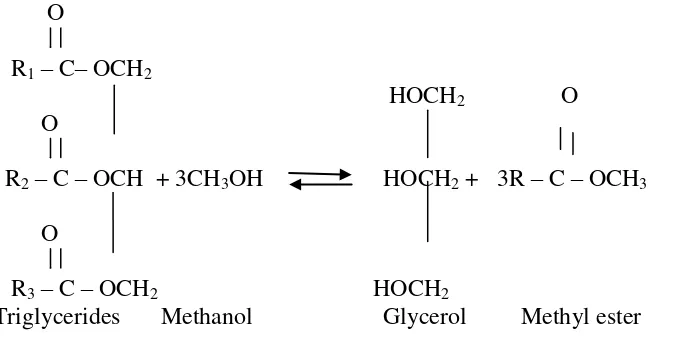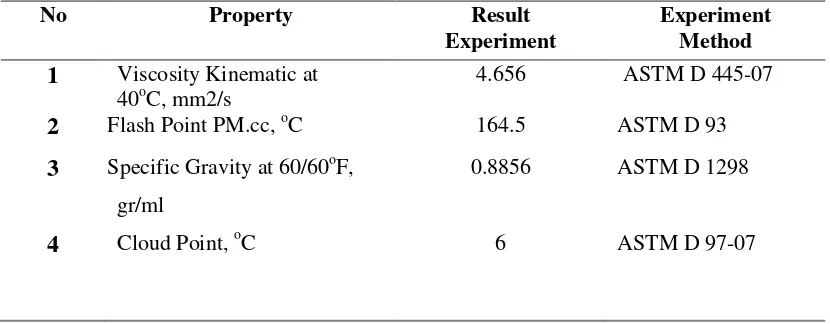International Conference on Green World in Business and Technology 2014
D-34
Biodiesel Production from Rubber Seed Oil with
Trans-esterification Process
Siti Salamah , Wahyu H, Setya A.,W.
Chemical Engineering Study Program Faculty of Technology Industry Ahmad Dahlan University
Campus III, Jln Prof. Soepomo, Janturan Yogyakarta
Abstract
Diesel fuel needs are increasing with the depletion of petroleum reserves demanded to undertake the manufacture of alternatives fuels, one of which is biodiesel. Biodiesel fuel and fuel adiditive are derived from organic, renewable feed stocks. Rubber seed oil is one type of vegetable oil that can be processed into biodiesel. This study is conducted the trans-esterification process with variable mole ratio and reaction time. The first stage is the esterification process in order to reduce FFA level contained in the rubber seed oil to ≤ 2 %. Ester which has been produced is processed into biodiesel by trans-esterification process using methanol solvent and KOH. The process of reacting ester and 50 ml of a 0.44 gr KOH (1% from the weight of ester) in a three-neck flask heated using water batch with temperature at 600C and stirring speed 600 rpm. Variable used is mole variation, 1:4, 1:5 and 1:6 and the reaction time variations are 60, 120, and 180 minutes. Reaction products which has been formed is precipitated about + 24 hours to separate the biodiesel with glycerol, and then washed it with water that has been heated by 10% of the total volume of biodiesel and separated again by using a funnel separator + 24 hours. Biodiesel obtained was distilled to evaporate residual catalyst, soap and water. The quality of biodiesel was tested in the laboratory of Technology Oil Gas and Coal Chemical Engineering Department, Faculty of Engineering, Gadjah Mada University. The results were obtained clear yellow biodiesel and glycerol as the other result. Optimal conditions obtained in the mole ratio variation is 1:5 with the results of biodiesel volume 48 ml, and the optimal condition at 60 minutes reaction time, the biodiesel volume produced is 96 % V .
Key Words: Biodiesel, rubber seed oil, trans-esterification,
1. Introduction
D-35 producing rubber seed oil about 25,622,406.8 L / year. It has not been widely use rubber seeds [3]. The results rubber seed oil cannot be directly used as biodiesel, because the rubber seed oil contains of FFA (Free Fatty Acid). The FFA contained in the rubber seed should not exceed 2% to produce biodiesel. Trans-esterification process will not occur if the FFA in the oil is about 3%. Process carried out in order to decrease FFA. The FFA levels in rubber seeds are to decrease until to 2% so it can be processed into biodiesel [5]. Rubber seed oil contains saturated fatty acids and unsaturated fatty acids. Based on the chemical properties of rubber seed oil was non edible fat. Based on the physical properties results, it is showed that the rubber seed oil has properties so the oil could feasibly be used as raw material for the production of biodiesel feedstock [3]. Intake of rubber seed oil can be done by pressed and extracted with solvents. If the rubber seed is taken by pressing it, it will produce brownish yellow oil with a distinctive aroma. Besides that, the retrieval can be done by extracted rubber seed that results yellow bright oil, but less efficient if the oil needed in large quantities because of the time required for the extraction is longer [6].
The advantages of biodiesel are [1]: Have a higher cetane number (>60) so the efficiency of combustion is better and reduce detonation or knock on the machine, have the lubrication properties to the piston engine. Biodegradable (decompose) is a renewable energy because it made of natural ingredients which renewable. The advantages from using rubber seed [6] which is renewable energy source, improve the economy of fuel, more economical, and environmentally friendly. According [8], esterification process is running slowly and irreversible. Trans-esterification reaction is a chemical process of exchanging alkoxy group of an ester compound with alcohol. Trans-esterification is the removal alcohol reaction from an ester by another alcohol which includes a series of three consecutive reversible reaction. The first reaction is convertion of triglycerides into diglycerides, conversion of diglycerides into monoglycerides, and the last is convertion of monoglycerides into glycerin. At each stage of the reaction produces esters (1). According to Salamah (2012), trans-esterification reaction lasts about 0.5-1 hour at a temperature 40oC until formed two layers. The bottom layer is glycerol and the top layer is methyl ester. Biodiesel synthesis through the trans-esterification reaction between oil composed of trglycerides with methanol molecules:
Trigliserida + Metanol Gliserol + Metil ester
2.Experimental
2.1.Analysis of Free Fatty Acid (FFA)
International Conference on Green World in Business and Technology 2014
D-36
2.2. Esterification process to decrease levels of FFA from the oil:
Setting up of rubber seed oil and methanol with mole ratio 1:6 and 1.5 N H2SO4, 1.5% from of rubber seed oil. Reacting the rubber seed oil, methanol and H2SO4, in three neck flask equipped with a cooling loop, stirrer, thermometer and water bath as heated. Reaction at 60 0C and stirring at 600 rpm for 60 minutes. Heating the reaction to remove methanol and water. The result FFA levels of esterifiksai results obtained. If the FFA content of <2 then continue with the process of make biodiesel.
2.3.Trans-esterification Process
Take 50 ml of ester, add 18 ml of technically methanol which has been added with 0. 44 gr KOH (1% from the ester weight). The mixture was put into a three-neck flask and heat with water batch for 60 minutes at 60oC temperature and stirring speed 600 rpm. Put the result from trans-esterification process into a separator funnel and left it for 24 hours to complete the separation until formed two layers, the top layer is methyl ester (biodiesel) and bottom layer is glycerol. The experiment was repeated with variations of mole ratio (1:4, 1:5, 1:6) with vary amount of methanol and ester in accordance with the result of the mole ratio. The experiment was repeated with the same procedure with the variation time reaction 60, 120 and 180 minutes.
Research Scheme
The research scheme can be seen in the schematic below:
Methanol Methanol
H2SO4 p.a. KOH
Esterificati on
Trans-esterification
Washing
Distilation Separation
BIODIESEL FFA < 2 %
D-37
3. Result and Discussion
3.1. Decrease of FFA (Free Fatty Acid) Rubber Seed Oil
Result FFA analysis of rubber seed oil obtained first FFA content 8.232%. After a decline with esterification process using H2SO4 concentrates FFA content 1.3067%, from this result is worth to manufacturing biodiesel process by using rubber seed oil.
3.2. The Influence of Material Mole Ratio
In the manufacture of biodiesel with mole ratio variable, this experiment done for about 60 minutes, stirring speed is 600 rpm, and the temperature is 60 oC.
The following experimental data are presented in table 1:
Table 1. The relationship between material mole ratio with biodiesel volume
From table 1 it can be known % of the optimum result of biodiesel volume is in mole ratio 1:5 with methanol reactant 18 ml and 50 ml of oil. Theoritically, the addition of methanol can increase the biodisel result, but after reaching the optimum point decline % of result volume. It is because the trans-esterification reaction is reversible reaction. In this study indicates the equilibrium will shift to the left when the reaction has passed the optimum point so that the amount of product (biodiesel) has decreased.
O
R1– C– OCH2
HOCH2 O O
R2– C – OCH + 3CH3OH HOCH2 + 3R – C – OCH3
O
R3– C – OCH2 HOCH2
Triglycerides Methanol Glycerol Methyl ester
No. Mole Ratio Volume Biodiesel
Produced (ml) Biodiesel (% V)
1. 2. 3.
1:4 1:5 1:6
36 48 44
International Conference on Green World in Business and Technology 2014
D-38
3.3. The Influence of Reaction Time Variation
In this variable, the experiments done by using mole ratio 1:5 because this mole ratio can produce the highest volume of biodiesel. The following experimental data presented in figure1 1:
Figure 1. Graphic of the relationship between the time variations with % biodiesel volume
From graphic 1 can be seen that the longer the time reaction, the less biodiesel volume. According [8], this is happen because the trans-esterification is a reversible reaction, to obtain a large biodiesel, then methanol that is given has to be exessive, naturally the methanol itself is volatile, so the length of reaction time will speed up evaporation as supported by relativelly remained heat (T = 60o C, the boiling point of methanol is 64.7o C ). As the result, the amount of methanol to react with fatty acid decreased, this has resulted the biodiesel amount that is formed is also decreased.
The quality of biodiesel was tested in the laboratory of Oil Gas Technology and Coal Chemical Engineering Department, Faculty of Engineering, Gadjah Mada University, Yogyakarta, Indonesia. The result is the yellow colour of biodiesel from rubber seed oil quality is listed in Table 2 below:
Table 2. Physical properties of biodiesel
No Property Result
Experiment
Experiment Method
1 Viscosity Kinematic at 40oC, mm2/s
4.656 ASTM D 445-07
2 Flash Point PM.cc, oC 164.5 ASTM D 93
3 Specific Gravity at 60/60oF,
gr/ml
0.8856 ASTM D 1298
4 Cloud Point, oC 6 ASTM D 97-07
%
bio
d
iese
l
vo
lu
me
time variation
Graphic shows the relationship between the time variation with the % biodiesel volume
60
120
D-39 Table 2 shows the research results obtained by biodiesel from rubber seed has properties. According to ISO quality standards of quality Biodiesel Indonesia (RSNI EB 020551).
The heat test result shows the result is 9520.684 Kal/gr. According [9] the major heat is a good size because it is above the heat on ISO standards, biodiesel heat in general is 9206 Kal/gr.
4. Conclusion
From the result of the research, the researchers could draw conclusion as follows: 1. The rubber seed oil can process to biodiesel with esterification process to be
continue by transesterification process .
2. The optimum time reaction trans-esterification proces was 60 minute with biodiesel volume 48 ml. The optimum mole ratio was 1:5 with bioidiesel 96% volume .
5.Reference
[1] Sivaprakasam, S.,Saravanan,C.G., (2007), “Optimization of the Tranesterification Process for Biodiesel Production and Use of Biodiesel in a Compreession Ignition Engine “, Enerfy & Fuel Journal, 21, 2998-3003
[2] TIMNAS BBN, (2008), ”Bahan Bakar alternatif dari tumbuhan sebagai pengganti minyak bumimdan gas” Eka Cipta Fondation, penebar Swadaya, Jakarta
[3] Salamah,S.(2012), Characterization of Rubber Seed Oil and The Decreased in the Value of FFA as a Introduction to Produce of Alternatife Fuels Biodiesel. Prosiding ISBN : 978-979-3812-25-0. Proceeding of International Conference on Green World in Business and Technology March 23-24, 2012. Ahmad DahlanUniversity Yogyakarta. (page 45-52 )
[4] Prihandana, R., Hendroko, R., (2007), “Energi Hijau, Pilihan Bijak Menuju Negeri Mandiri Energi” Penebar Swadaya , Jakarta
[5] Ramadhans, A.S., Mulareedharan, C., Jayaraj, S.,2005. “Performance and emission evaluation of diesel engine fueled with methyls esters of rubber seed oil”, Renewable Energy, 30, 1789-1800
[6] Fitri Yuliani, dkk., 2009.” Pengaruh Katalis Asam (H2SO4) dan Suhu
Reaksi pada Reaksi Esterifikasi Minyak Biji Karet (Hevea brasiliensis) Menjadi Biodiesel. Laboratorium Biomassa dan Energi, Institut Teknologi Sepuluh Nopember, Surabaya.
[7] Wiyarno, B., (2010), “Biodiesel Microalgae, Bahan Bakar Alternatif Generasi ke tiga”, Era Pustaka utama , Solo, Indonesia
International Conference on Green World in Business and Technology 2014

